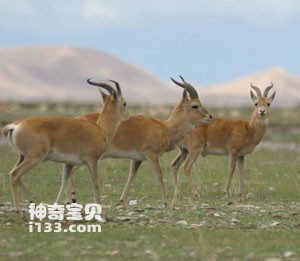Przewalski's gazelle, also known as beach gazelle and yellow sheep, was discovered and named by Russian naturalist Przewalski in 1875 on the Ordos grassland in Inner Mongolia, China. Przewalski's gazelle is a rare and endangered species unique to China. There are less than 600 of them left, which is rarer than the giant panda.
Przewalski's gazelle is about 100 cm long, with a tail length of 7 to 10 cm and a weight of 21 to 32 kg. The whole body is yellowish brown with white hip spots. Only males have horns, and the tips of the two horns are hooked and facing each other. It lives in the flat basins between mountains and the semi-desert areas around lakes, in groups of several or dozens of heads, and often in large groups in winter. It feeds on sedges, grasses and other sand plants. It estruses from November to January and gives birth from June to August, with one cub per litter.

Once widely distributed in Inner Mongolia, Ningxia, Gansu and Qinghai. Due to the impact of human activities and habitat degradation, the number of this species has declined and the distribution area has sharply decreased. Now Przewalski's gazelle is only distributed in Qinghai Province, including around Qinghai Lake, as well as Tianjun County and Gonghe County.
Przewalski's gazelle belongs to the family Bovidae of the order Artiodactyla. There are less than 600 of them in the world, and they are only distributed around Qinghai Lake. The critically endangered status of Przewalski's gazelle has attracted worldwide attention. The International Union for Conservation of Nature (ICUN) has published the Red List and the 1998 Red Data of Endangered Animals in China, which has rated the endangered status of Przewalski's gazelle as (CR). In 2000, Przewalski's gazelle was listed as one of the 15 major species protected by China's Wildlife Conservation Project.
To save Przewalski's gazelle, we need our joint efforts! Please join us in taking action!
animal tags:
We created this article in conjunction with AI technology, then made sure it was fact-checked and edited by a Animals Top editor.